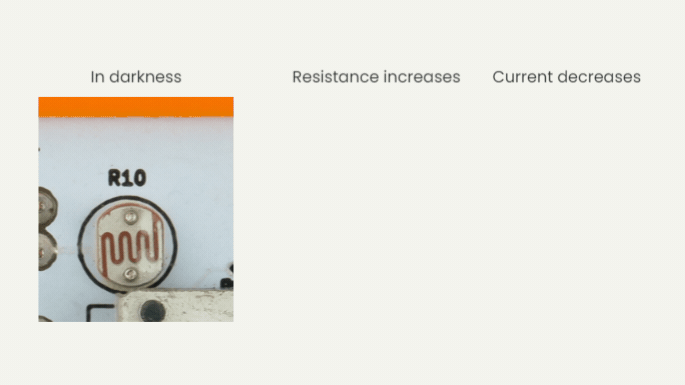

6 year-old Tanisha received “Havi – DIY Smart Lighting Kit” as a birthday gift. She was amazed at building a smart street light and smart night lamp that goes off under light and turns on in darkness.
But we are not talking about the kit, we are talking about Tanisha. After all, she is Ta-ni-sha.
As she successfully made projects using the kit, Everyone started finding the place to hide behind to save themselves from the series of questions about to start from the curious mind of Tanisha.
And so we thought of writing this post to help you answer all the questions you would have about Light sensor, LDR, its working principle, physics behind it, applications of the light sensor, how LDR sensor works in smart street light and others.
Go on…..
What is LDR?
If you observe carefully, the light sensor has this component on it.

A resistor is something that resists the flow of current in any circuit.
Take for example an injection syringe. What will happen if you press the handle of the syringe? The liquid inside will come-out right?
And what will happen if there is a needle attached with the injection? The liquid will still come out but flow would be narrowed, correct?
So that needle works as a resistor for the flow of liquid.
A resistor in electronics does the same, for the current.
Now, after understanding the resistor, let’s come back to our Light Dependent Resistor or LDR.
Can you guess something out of the name itself?
Light – Dependent – Resistor.
Yes, a resistor that depends on the light to increase or decrease its resistance. That light can be sunlight, torch light, bulb, laser or even IR light.
The physics of LDR sensor
Now take another close look at LDR on your light element. What do you see?
You will notice a specific pattern

The pattern you see is in zigzag form. That is to achieve the desired power rating and resistance in limited space. Do more in less space!
Now this photo sensitive conductor has a characteristic. When light falls on it, the material decreases its resistance. But why? Let’s see.
How LDR works? How does LDR detect the light?
You know a material will have electrons.
In the photo conductive material used in LDR, there are two bands.
- Valence band – electrons are resting.
- Conduction band – electrons are active, hence passing the current.
All the electrons in the photo conductive material are resting in the valence band, like there is no tomorrow, nothing is happening, and that’s the state of resistance. Electrons sitting in the valence band won’t let the current pass.
But here comes the Mommy!! The light.
The photons in the light are super charged and have much higher energy than the bandgap of the conductive material. These photons wake the electrons up, super charge and inspire them to cross the valence band and move to the conduction band.
This….. This move makes the resistance weaker, from some Mega Ohm of resistance earlier to less then even a hundred of ohms. Resistance dropped, current has passed and the circuit has activated!
The effectiveness of LDR depends on the intensity of the light. Brighter the light, more the current.
So how does the Light sensor circuit work?
Let’s make a circuit: Power + Light + LED

When light falls on LDR, the resistance decreases, current flows and reaches to the LED element and makes the LEDs glow up!
Clear?
The next element can be a buzzer or motor too, instead of the LED.
The amount of current it will let pass or say resistance of the LDR depends on the intensity of the light it receives. Brighter the light, lesser the resistance. Lesser the resistance, more current and more chances or LEDs to glow up!


And to adjust that intensity level, we use this black nob called Potentiometer. Set it to 0 and the sensor will not detect any light. Set it to max and the sensor will let the current pass even if there is no light and set it in between to make it detect low to bright light.
Do the experiment yourself.
Light sensor applications
There are several uses and applications of LDR or Light sensors. Few of them are described here.
1. Light sensors are used in cellphones, tablets and laptops to automatically adjust the screen brightness according to the ambience light. When the user is using the device in darkness, the sensor will detect the low light and will send signs to screen to cut down on the energy use. That will protect the eyes too.
2. In houses, street lights and automobiles, the lights are turned on and off in coordination with sunlight. That is done with a LDR sensor. Not only on and off, we can control the brightness of the lights according to the environment to unify the lighting experience.
3. Light sensors are used in the cargo containers to log the time every time the container is opened. That’s how light sensors are used for security and privacy measures as well.
4. How come we forget agriculture? LDR sensors are great problem solvers for farmers, mostly dependent on natural resources and their own hard work to grow food for all of us. Light sensors help them with syncing the water sprinkling, harvesting and other processes with the sunlight.
One last thing, LDR is not the only component which can be used to detect light in a light sensor. You can use Photodiodes and a few other components too.
So now you know how a light sensor works and what is the use of LDR.
Now be creative and start building creations of light sensor using Havi Elements.
